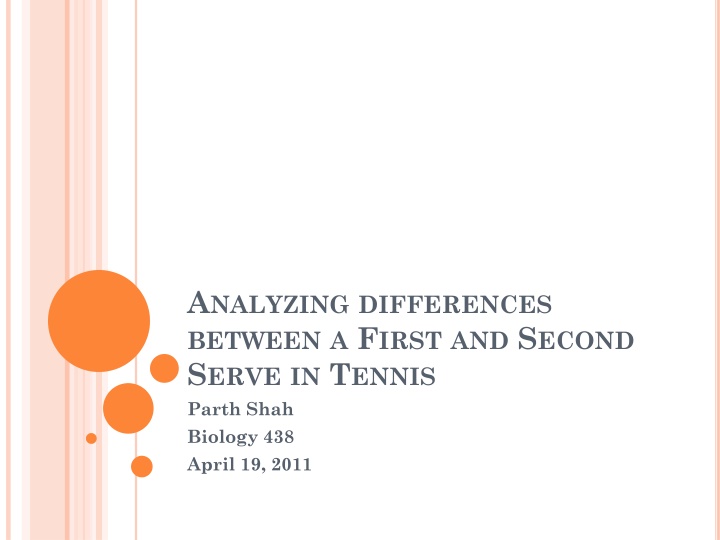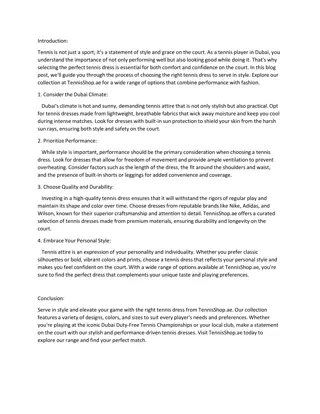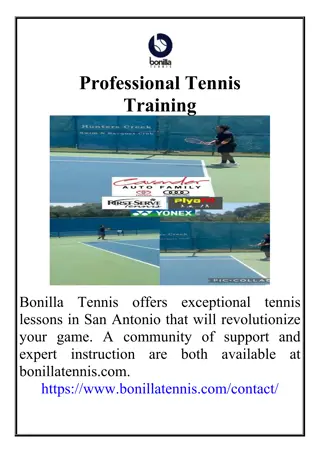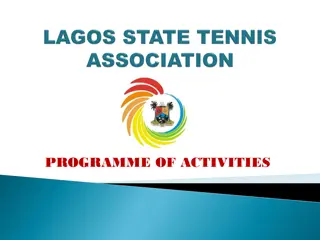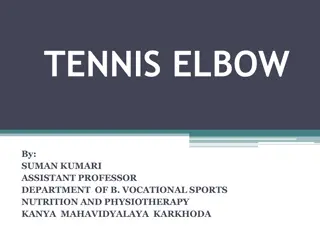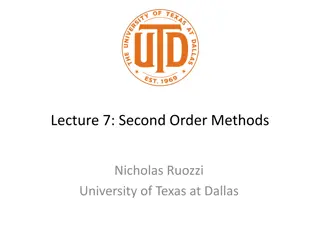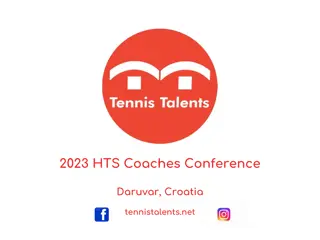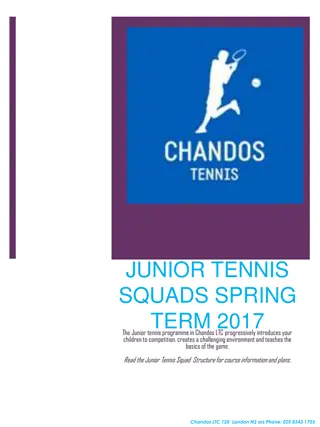Analyzing Differences Between First and Second Serve in Tennis
Tennis serves are crucial in determining the outcome of a match. This study delves into the distinct characteristics of first and second serves, exploring power generation, kinetic energy transfer, and muscle movements involved. Hypotheses are formulated to investigate these differences, focusing on factors like force generation and efficiency in transferring energy to the ball. Visual aids and detailed analysis provide insights into the complexities of serving in tennis.
Download Presentation

Please find below an Image/Link to download the presentation.
The content on the website is provided AS IS for your information and personal use only. It may not be sold, licensed, or shared on other websites without obtaining consent from the author.If you encounter any issues during the download, it is possible that the publisher has removed the file from their server.
You are allowed to download the files provided on this website for personal or commercial use, subject to the condition that they are used lawfully. All files are the property of their respective owners.
The content on the website is provided AS IS for your information and personal use only. It may not be sold, licensed, or shared on other websites without obtaining consent from the author.
E N D
Presentation Transcript
ANALYZING DIFFERENCES BETWEEN A FIRST AND SECOND SERVE IN TENNIS Parth Shah Biology 438 April 19, 2011
TENNIS: A SPORT Tennis is a sport that uses several different muscles groups in different types of strokes: Forehand Backhand Slice Serves The most complex motion, according to experts, is the Serve, which is the focus of my discussion today.
SERVE: WHATARETHEYANDWHYDOWE CARE? Serves are a series a complex of muscles movements that I discuss later Serves are important part of the game because % of first and second serves has a significant effect on the outcome of the game. Professionals tend to have a faster serve (presumably with more power) than their 2nd serves due to the fact that if the 2nd serve does not go in, the player automatically loses that point. Top 10 Players usually have serves greater than 150km/hr to make it difficult for the opposing player to return the serve, which is has been shown by research.
SERVES: HOWDOESITHAPPEN? Serves involve a motion of different body parts in a very precise fashion, that contribute to the racquet speed: 1) the shoulder external rotation 2) the wrist extension 3) the twist rotation of the lower trunk 4) the twist rotation of the upper trunk, 5) the shoulder abduction, 6)the elbow extension, 7) the ulnar deviation rotation 8) the second twist rotation of the upper trunk 9) the wrist flexion.
SERVE: A MOREVISUALWAYTOTHINK ABOUTIT Deceleration & then follow- through Cocking Acceleration
HYPOTHESIS Since serves are important part of the game, I am particularly interested in differences between first and second serves: Hypothesis I: Does the player (me) generate less power and force in the 2nd serve than in the 1st serve? Hypothesis II: Does the (%) kinetic energy transferred to the ball in the 2nd serve lower than that is transferred to the ball in the 1st serve?
V(f) FIRST (FLAT) SERVE: FORCE 35 30 Velocity (m/s) 25 20 15 Head TiS5 Mass = 0.252kg Radius=0.6875m 10 5 0 0 0.005 0.01 0.015 0.02 Time starting with frame before impact (s) Racquet Ball
FIRST SERVE: ENERGYOF RACQUET Instant After Impact Instant Before Impact
SECONDSERVE: FORCE V(f) Head TiS5 Mass = 0.252kg Radius=0.6875m 35 30 Velocity (m/s) 25 20 15 10 5 0 0 0.005 Time starting with frame before impact (s) 0.01 0.015 0.02 0.025 0.03 Racquet Ball
SECONDSERVE: ENERGYOFRACQUET Instant After Impact Instant Before Impact
POWER Second Serve First Serve
ANGULARVELOCITY First Serve: 4.088-4.212: 0.124s Second Serve: 3.680-3.752= 0.072s Travelling radians Travelling radians Angular Velocity = /0.072 = 43.63 Angular Velocity = /0.124 = 25.34
RESULTS 1st Serve 42.48 2nd Serve 110.58 Kinetic Energy of Racquet Before Impact (J) Kinetic Energy of Racquet After Impact (J) 11.56 55.33 Difference in Kinetic Energy (J) Kinetic Energy of Ball After Impact (J) Potential Energy of Ball After Impact (J) 30.92 28.61 1.31 55.25 19.26 1.12 Potential Energy of Ball Before Impact (J) 1.32 1.12 Total Energy Transferred (J) % Energy Transferred 28.60 93% 19.26 35% Speed of Ball After Impact (m/s) Force (Centripedal) (N) Angular Velocity ( ) 31.69 97.94 25.34 26.00 254.94 43.63 Power (Watts) 3865 3425
SO, WHATDOESTHEDATASAY The 2nd serve (top-spin) transfers less % Energy to the ball from the racquet than the 1st serve (flat). The 2nd serve generates more force and angular velocity than the 1st serve. The velocity of the ball in the 2nd serve is lower than that in the 1st serve.
CONCLUSIONS Why did the % of Kinetic Energy Transfer drop off sharply in the 2nd serve? Unlike the first serve, the 2nd serve is a top spin serve. This implies that the racquet grazes the ball, and more of the energy is transferred to the ball s rotational velocity than linear velocity. This explains why the tennis ball in the top-spin serve has a lower speed than the flatter serve. Why might the 2nd serve generate more force than the 1st serve? At first, it might not seem intuitive (it clearly wasn t to me since I made the opposite direction), but we can probably attribute it to the fact that a much lower % of Energy is transferred to the ball in the top-spin serve than in the flat serve. In order to have some acceptable velocity in addition to the extra spin, the 2nd serve might need to generate more force
COMPARISONS Vs. First Serve Speed~ 67.5mph First Serve Speed~ 155mph Not even half as good still close to an average tennis player (~ 70mph)
FUTUREINVESTIGATIONS Compare a top-spin forehand with a flat forehand for the observable differences. It would be interesting to see whether there is a similar difference in the % energy transferred to the ball compared with the force generated on both of those shots
REFERENCES Konda, Shoji, Toshimasa Yanai, and Shinji Sakurai. "Scapular Rotation to Attain the Peak Shoulder External Rotation in Tennis Serve." Journal of the American College of Sports Medicine. 42.09(2010): 1745-1753. Kibler, William, T Jeff Chandler, Robert Shapiro, and Michael Conuel. "Muscle activation in coupled scapulohumeral motions in the high performance tennis serve." British Journal of Sports Medicine. 41.11 (2007): 745-749.
